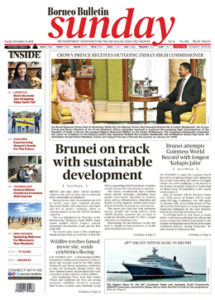Aseanews Headlines: Brunei on track with sustainable development

BRUNEI and nine other ASEAN member countries are well on their way to achieving more sustainable development.
Strong income and consumption growth in recent years have reduced poverty, improved health and education outcomes, and led to greater inclusion, albeit to varying degrees across the ASEAN member countries.
This was highlighted on Thursday in the International Monetary Fund (IMF)’s latest report entitled ASEAN Progress towards Sustainable Development Goals and the Role of the IMF.
The report takes stock of the challenges ahead and provides an overview of how the IMF is supporting ASEAN member countries as they pursue their development agendas.
The report recommends that countries adopt specific strategies, including more quality government spending on priority areas such as infrastructure, education and health, to help improve welfare and ensure that the benefits of growth are widespread.
The report also said that with continued income growth and strong policies, most ASEAN member countries are on track to eradicate absolute poverty by 2030, a major milestone for Southeast Asia.
Maintaining this performance would also lead to significant improvements in health and education outcomes.
While basic health indicators show gaps, especially for the lower-middle income ASEAN member countries, there are encouraging bright spots.
For example, for the median ASEAN member country, mortality for children under the age of five currently stands at 24.5 per 1,000 live births, already below the global goal.
If income gains based on recent forecasts are realised, and if past trends for sustainable development indicators continue, the IMF’s research finds that economic welfare (measured by prosperity levels and quality of living standards) will continue to converge towards the levels found in Asia’s developed economies.
.
ADS by Cloud 9:
.
– SPACE RESERVE FOR YOUR ADVERTISEMENT –
.
.
On another note, IMF said the ASEAN member countries continue to achieve strong growth, projected to average 5.2 per cent for 2018.
Such growth rates have helped to lower poverty, boost incomes, and improve economic welfare.
Despite progress, the region still faces challenges in reaching the 17 objectives of the Sustainable Development Goals (SDGs) agreed by the international community that provide a blueprint for policies through 2030 in support of inclusive and environmentally sustainable development.
For example, income inequality remains elevated in several ASEAN member countries and the shift towards manufacturing is straining environmental sustainability.
Income inequality, as measured by the Gini coefficient – a commonly used measure of the income distribution – is almost 20 per cent higher in the median ASEAN member country than in advanced Asia.
Furthermore, life expectancy in the median ASEAN member country (at about 69 years) remains well below advanced Asia, a gap that is projected to persist through 2030, suggesting that there is significant room to improve health outcomes.
This is especially true in many lower middle-income ASEAN member countries, which also need to invest more to close infrastructure gaps.
| Azlan Othman |
.
ADS by Cloud 9:
.
– SPACE RESERVE FOR YOUR ADVERTISEMENT –
.
Aseanews Headlines:


.
ADS by Cloud 9:
.
– SPACE RESERVE FOR YOUR ADVERTISEMENT –
.
.

All photographs, news, editorials, opinions, information, data, others have been taken from the Internet..aseanews.net | [email protected] / For comments, Email to : Aseanews.net









